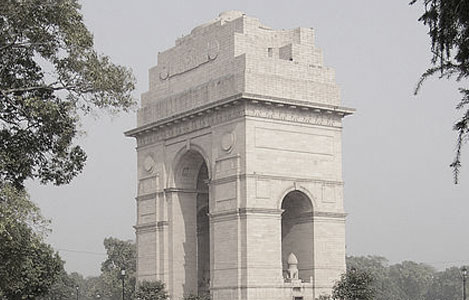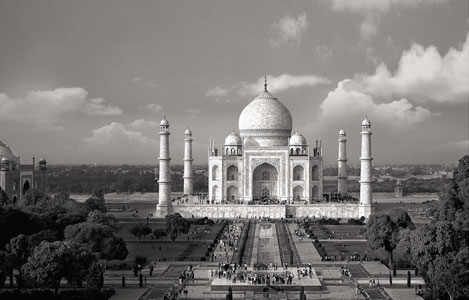Royal Rajasthan
Royal Rajasthan
New Delhi – Agra – Jaipur – Pushkar – Jodhpur – Udaipur – New Delhi
October to March – Possible Year Round
Rajasthan’s romantic past comes to life on this tour which includes some well known wonders as well as some little known pearls. Come explore this marvelous landscape where palaces tower against the stark desert landscape, often only broken by the colorful dress of the turbaned men and sari clad women. The tour visits the desert citadel of Jaisalmer, the dreamlike Udaipur with its lakes and palaces and the Taj Mahal in Agra. Experience the beauty of oasis-like villages and painted havelis and see why Rajasthan is a destination to be revisited again and again.
Highlights
- The Golden Triangle is just the beginning. Romantic destinations abound.
- Udaipur – good enough for a James Bond villain
- Deluxe coach travel. Oh yes, and elephants and camels, too.
- Havelis and other luxury properties throughout
%
Days
%
Luxury
%
Destinations
Itinerary
Day 1 Delhi
You are greeted at the airport and escorted to your hotel. The day includes a sightseeing tour of Sir Edward Lutyens’ New Delhi, the garden city built in 1911 by the British. We also visit the Birla Mandir (Lakshminarayan Temple), the President’s House, Humayun’s Tomb (the forerunner of the Taj Mahal), and India Gate.
Day 2 Agra
The Mughal splendor of Agra is unparalleled. Largely thanks to the Taj Mahal and the Red Fort. The Taj Mahal is one of the wonders of the world. It was built in 1652 by Emperor Shah Jahan. It took 22 years and 20,000 skilled artisans to complete. The Agra Fort lies across the river Jamuna. It was here that Aurangzeb, the third son of Shah Jahan, kept his father under house arrest. One can get a fantastic view of the Taj from the little octagonal tower in the Fort.
Days 3 - 4 Jaipur
On the way to princely Jaipur we visit Fathepur Sikri, Akbar’s ghost city. It was built in honor of a Saint who foretold the birth of 3 sons to the Emperor. It features a parcheesi court, the game being played out with people as pieces. Jaipur, known as the ‘Pink City’ was founded by Maharaja Jai Singh II (1693-1743) and is the capital of Rajasthan. It is a city of contrasts where camels and elephants wait at the traffic lights along with cars and scooters. The whole city was painted Pink when the Prince of Wales, Edward VII, visited Jaipur in 1876. Today, every home in the old city is obliged by law to maintain this façade. While in Jaipur we visit Amber Fort, the former capital of the royal family of Jaipur, taking an elephant ride to the top. Another highlight is the City Palace, the former royal residence built in a blend of Rajasthani and Mughal styles. The palace houses a museum with a superb collection of Rajasthani costumes and Mughal and Rajput weapons. We also visit the Jantar Mantar observatory and the Hawa Mahal.
Day 5 Pushkar
En route, we break at Kishangarh, a charming little town famous for having the finest school of miniature painting in 18th century India. The old city of Kishangarh fringes an enormous lake. The ambience is decidedly medieval, and in many havelis, painters of miniatures are still at work. From Kishangarh it is a short journey to our stopping point at Pushkar, a small town built around a lake considered sacred to the Hindus. Hindus believe it is necessary to make a pilgrimage to bath in this lake at least once in a lifetime. The lake is bounded by 52 ghats built over the centuries by kings and nobles. The town is a maze of temples and hermitages, and is filled with ascetics and devotees.
Days 6 - 7 Jodphur
We begin our day with a visit to Ajmer which is one of the most important centers of pilgrimage for India’s Muslims. The great Sufi saint Muin-ud-din Chishti is buried at the Dargah Sharif in Ajmer — his followers now extend beyond Islam and it is said that a visit to his shrine will fulfill a devotee’s wish. There is a steady flow of pilgrims throughout the year giving the Dargah and its surroundings a bustling character quite different from the rest of Ajmer. We also visit the mosques, pavilions and gateways now surrounding the mausoleum. In particular we see the Adhai din ka Jhonpra, built in 1155, and restructured into a mosque in 1198. It is one of the finest monuments of medieval India, especially noted for the ornate calligraphic inscriptions. After visiting Ajmer we continue our journey to Jodhpur. Surrounded by the great Thar Desert, Jodhpur is fortressed by an immense wall six miles in circumference. This former capital of the Marwar State still retains much of its medieval character. Our sightseeing in Jodphur includes the Meharangarh fort, Jawant Thada and the old city. Meherangarh, or the Majestic Fort, is a structure so massive it seems to grow out of the cliff above Jodhpur city. As with other great Rajput forts, its general inspiration came from Man Sing’s fort at Gwalior, but for elegance of detail this palace is unsurpassed. On the way down from the palace is Jaswant Thada, the cenotaph built in 1899. We also visit the old city with its winding laneways and overflowing bazaars.
Days 8 - 9 Jaisalmer
Endless oceans of sand broken by dunes and the shattered scarps of the Aravalli range give a true desert ambience prior to arriving in Jaisalmer. This living area of this authentic desert citadel is contained within a curtain wall. The main bastion and royal palaces are further protected by huge ramparts and gates. Jaisalmer is a charming and unique maze of elaborately carved havelis. Built with the famous Jurassic sandstone, the town casts a lovely golden glow. We visit the fantastic Sonar Kila, the Fort dominating Gadisar Lake. We also explore some of the town’s beautiful havelis and simply wander around the market. One of the highlights of our stay includes a journey out into the desert sand dunes by camel for a view of the magnificent sunset over the Thar Desert.
Day 10 Khimsar
Morning takes us to Khimsar where we stay at the royal Fort. It is a beautiful and remote moated castle in the heart of rural India. The afternoon is spent exploring the surroundings.
Day 11 Kumbalgarh
En route to Kumbalgarh we visit Ranakpur, site of the famous Jain temples. The Chaumukha temple is one of the most complex in India, with 29 halls containing 1444 pillars, each covered with intricate carvings. The temple complex is set in a deep secluded valley filled with peacocks, monkeys, and other wildlife. From Ranakpur it is a short journey on to Kumbalgarh, set amidst the Aravalli hills.
Days 12 - 13 Udaipur
Before we set off for Udaipur we first visit Kumbalgarh’s impressive fort, actually a fortified city on top of a rocky peak. Enclosed within its great walls are palaces, temples, fields, and forests – everything needed to withstand a long siege! After the visit we continue on to Udaipur. Built by Maharana Udai Singh in the year 1559 on the banks of the lake Pichola, Udaipur is famed for its picturesque lakes. The old city is filled with narrow medieval roads and lanes, with a small temple at each turn, making the city one of the most charming in all Rajasthan. In Udaipur we visit the City Palace, which actually consists of a number of palaces forming a single beautiful facade over the Pichola Lake. We also stop at Jagdish Mandir, a Hindu temple complex built in 1651. One of the highlights of the tour is a dinner at the famous Lake Palace – now converted into a luxury hotel. The Palace floats like a snowflake in the middle of Lake Pichola and is considered one of the most romantic getaways in the world. During our stay in Udaipur there is also plenty of time for you to explore the streets and shops of the city’s bazaar.
Days 14 -16 Delhi
We travel back to Delhi by air. Here we visit Old Delhi, the ancient city built by Emperor Shah Jahan, the builder of the famous Taj Mahal. We visit the Red Fort, and then take a bicycle rickshaw ride through the narrow lanes to the Jama Masjid – the largest Mosque in India. Like New York, Delhi is constantly re-inventing itself so there is always plenty to see and do. On the final morning your voyage winds up with breakfast and transfer to airport for international departure.


























